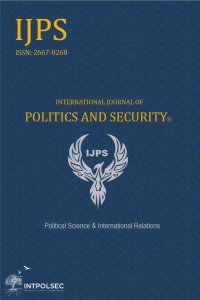Drug Abuse and its Implication on Regional Security in West and Central Africa: Cases Studies of Nigeria and Cameroon
Önceki literatür, uyuşturucu kullanımının çok sayıda sağlık riski oluşturabileceğini ortaya koysa da, bu tür vakaların ulusal ve bölgesel güvenliğe ne ölçüde tehdit oluşturabileceğini gösterememektedir. Dolayısıyla bu araştırma, Nijerya ve Kamerun'da terör örgütlerinden gençlere uzanan Tramadol kullanımına odaklanarak, uyuşturucu kullanımının ulusal güvenliğe ne ölçüde varoluşsal bir tehdit oluşturduğuna ışık tutmaktadır. Genel olarak, Tramadol, şiddetli ve orta derecede ağrıyı tedavi eden bir analjezik hap olarak kabul edilir. Ancak bu araştırmadaki analizin sonucu, tramadolün Nijerya'daki terörist ve organize suç grupları arasında ne kadar yaygın olduğunu ve Kamerun'un Douala ve Yaounde şehirlerindeki gençlik şiddetinin ve artan suç oranlarının itici gücü olduğunu ortaya koyuyor.
Anahtar Kelimeler:
Organize Suç, Uyuşturucu Kullanımı, Tramadol, Ulusal Güvenlik
Drug Abuse and its Implication on Regional Security in West and Central Africa: Cases Studies of Nigeria and Cameroon
Though previous literature establishes that abuse of drugs may amount to numerous health risks, they, however, fail to present the extent to which such cases could constitute a threat to national and regional security. Therefore, this research sheds light on the extent to which drug abuse constitutes an existential threat to national security by focusing on the use of Tramadol extending from terrorist organizations to youth in Nigeria and Cameroon. In general, Tramadol is considered an analgesic pill that treats severe and moderate pain. But the outcome of the analysis in this research reveals the extent to which tramadol is prevalent among the terrorist and organized crime groups in Nigeria, and it is the driver of youth violence and heightened crime rates in Cameroonian cities of Douala and Yaounde.
Keywords:
Drug Abuse, National Security, Organized Crime, Tramadol,
___
- Buzan, B., & Hansen, L. (2009). The evolution of international security studies. Cambridge University Press.
- Buzan, B., & Wæver, O. (2009). Macrosecuritisation and security constellations: reconsidering scale in securitisation theory. Review of international studies, 35(2), 253-276.
- Caballero-Anthony, M. (Ed.). (2015). An introduction to non-traditional security studies: a transnational approach. Sage.
- Cameroon Anti-drug National Committee (2018). Rapid assessment of drug abuse in Cameroon; Ministry of Public Health CRM
- Diab, M., Veronese, G., Jamei, Y. A., & Kagee, A. (2020). Risk and Protective Factors of Tramadol Abuse in the Gaza Strip: The Perspective of Tramadol Abusers and Psychiatrists. International Journal of Mental Health and Addiction, 1-17.
- Drug Enforcement Administration (2014). Schedules of Controlled Substances: Placement of Tramadol into Schedule IV
- Gupta, S., Nguyen, T. D., Freeman, P. R., & Simon, K. I. (2020). Competitive Effects of Federal and State Opioid Restrictions: Evidence from the Controlled Substance Laws (No. w27520). National Bureau of Economic Research.
- Hough, P., Moran, A., Pilbeam, B., & Stokes, W. (2015). International security studies: theory and practice. Routledge.
- Johnson, B., Richert, T., & Svensson, B. (2020). Physical Violence and Property Damage towards Parents, Committed by Adult Children with Drug Problems. Journal of Family Violence, 1-16.
- Lapaque P. (2020). Remarks by the UNODC Regional Representative in West and Central Africa on tramadol and its security and health implications: Published by United Office of Drugs and Crime Retrieved from https://www.unodc.org/westandcentralafrica/en/2017-12-11-unodc-warns-tramadol-use.html. Muyideen, O. F. (2020). Predictors of Violence among Drug Abusers in Selected Drug Joints in Mushin, Lagos Metropolis. Randwick International of Social Science Journal, 1(2), 211-221.
- National Survey of Drug Use and Health-NADUH (2019). Key Substance Use and Mental Health Indicators in the United States: Results from the 2018 National Survey on Drug Use and Health, Retrieved from https://www.samhsa.gov/data/release/2019-national-survey-drug-use-and-health-nsduh-releases accessed on 18/12/2020
- Rajesh, K., Wilcox, G., Ring, D., & Mackert, M. (2020). Reactions to the opioid epidemic: A text-mining analysis of tweets. Journal of addictive diseases, 1-6.
- The DAWN Report (2012). Findings on Drug-Related Emergency Department Visits; Drug Abuse Warning Network (DAWN), Retrieved from https://www.samhsa.gov/data/sites/default/files/DAWN096/DAWN096/SR096EDHighlights2010.htm accessed on 22/12/20
- U.S. Department of Health and Human Services (2016) The Opioid Epidemic in the U.S., October, https://www.hhs.gov/sites/default/files/2017-opioids-infographics.pdf
- UNODC (2018). Drug Use in Nigeria: Published by United Office of Drugs and Crime, retrieved from file:///D:/Drug_Use_Survey_Nigeria_2019_BOOK.pdf accessed on 20/12/20
- Wall Street Journal (2020) “Tramadol: The Opioid Crisis for the Rest of the World,”, https://www.wsj.com/articles/tramadol-the-opioid-crisis-forthe-rest-of-the-world-1476887401
- World Health Organization (2018). Management of substance abuse; WHO Expert Committee on Drug Dependence retrieved from https://www.who.int/substance_abuse/right_committee/en/ accessed on 22/12/20.
- ISSN: 2667-8268
- Yayın Aralığı: Yılda 2 Sayı
- Başlangıç: 2019
- Yayıncı: Fikret BİRDİŞLİ
Sayıdaki Diğer Makaleler
Turkey’s Preventive Operations against Terrorists across Southern Border
Emerging Cyber Security Threats: India’s Concerns and Options
The Issue of Political Recognition in International Policy: The Case of Kosovo
Transformation of Israeli Security Organizations after the Yom Kippur War
